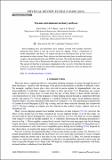| dc.contributor.author | Nasto, Alice Meite | |
| dc.contributor.author | Brun, P.-T. | |
| dc.contributor.author | Hosoi, Anette E | |
| dc.date.accessioned | 2018-03-26T19:19:02Z | |
| dc.date.available | 2018-03-26T19:19:02Z | |
| dc.date.issued | 2018-02 | |
| dc.date.submitted | 2017-07 | |
| dc.identifier.issn | 2469-990X | |
| dc.identifier.issn | 2469-9918 | |
| dc.identifier.uri | http://hdl.handle.net/1721.1/114296 | |
| dc.description.abstract | Nectar-drinking bats and honeybees have tongues covered with hairlike structures, enhancing their ability to take up viscous nectar by dipping. Using a combination of model experiments and theory, we explore the physical mechanisms that govern viscous entrainment in a hairy texture. Hairy surfaces are fabricated using laser cut molds and casting samples with polydimethylsiloxane (PDMS) elastomer. We model the liquid trapped within the texture using a Darcy-Brinkmann-like approach and derive the drainage flow solution. The amount of fluid that is entrained is dependent on the viscosity of the fluid, the density of the hairs, and the withdrawal speed. Both experiments and theory reveal an optimal hair density to maximize fluid uptake. | en_US |
| dc.description.sponsorship | United States. Army Research Office (Grant W911NF-15-1-0166) | en_US |
| dc.publisher | American Physical Society | en_US |
| dc.relation.isversionof | http://dx.doi.org/10.1103/PhysRevFluids.3.024002 | en_US |
| dc.rights | Article is made available in accordance with the publisher's policy and may be subject to US copyright law. Please refer to the publisher's site for terms of use. | en_US |
| dc.source | American Physical Society | en_US |
| dc.title | Viscous entrainment on hairy surfaces | en_US |
| dc.type | Article | en_US |
| dc.identifier.citation | Nasto, Alice et al. "Viscous entrainment on hairy surfaces." Physical Review Fluids 3, 2: 024002 © 2018 American Physical Society | en_US |
| dc.contributor.department | Massachusetts Institute of Technology. Department of Mathematics | en_US |
| dc.contributor.department | Massachusetts Institute of Technology. Department of Mechanical Engineering | en_US |
| dc.contributor.mitauthor | Nasto, Alice Meite | |
| dc.contributor.mitauthor | Brun, P.-T. | |
| dc.contributor.mitauthor | Hosoi, Anette E | |
| dc.relation.journal | Physical Review Fluids | en_US |
| dc.eprint.version | Final published version | en_US |
| dc.type.uri | http://purl.org/eprint/type/JournalArticle | en_US |
| eprint.status | http://purl.org/eprint/status/PeerReviewed | en_US |
| dc.date.updated | 2018-02-07T18:00:50Z | |
| dc.language.rfc3066 | en | |
| dc.rights.holder | American Physical Society | |
| dspace.orderedauthors | Nasto, Alice; Brun, P.-T.; Hosoi, A. E. | en_US |
| dspace.embargo.terms | N | en_US |
| dc.identifier.orcid | https://orcid.org/0000-0001-8421-5583 | |
| dc.identifier.orcid | https://orcid.org/0000-0003-4940-7496 | |
| mit.license | PUBLISHER_POLICY | en_US |
